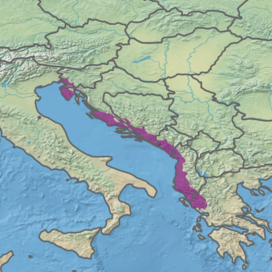Illyrian deciduous forests
| Illyrian deciduous forests | |
|---|---|
 | |
 Ecoregion territory (in purple) | |
| Ecology | |
| Realm | Palearctic |
| Biome | Mediterranean forests, woodlands, and scrub |
| Borders | Aegean and Western Turkey sclerophyllous and mixed forests, Dinaric Mountains mixed forests, Pindus Mountains mixed forests and Po Basin mixed forests |
| Geography | |
| Area | 39,390 km2 (15,210 sq mi) |
| Countries | |
| Conservation | |
| Conservation status | critical/endangered |
| Protected | 8,855 km² (22%)[1] |
The Illyrian deciduous forests is a terrestrial ecoregion in southern Europe, which extends along the eastern coast of the Adriatic Sea. It belongs to the Mediterranean forests, woodlands, and scrub biome, and is in the Palearctic realm.
Geography[]
The Illyrian deciduous forests stretch along the eastern coast of the Ionian and Adriatic Seas, and occupies 40,600 km2 (15,700 sq mi) in Northern Greece, Albania, Montenegro, Bosnia and Herzegovina, Croatia, Slovenia and Northern Italy around Trieste.
The ecoregion is bounded by the Aegean and Western Turkey sclerophyllous and mixed forests (in Greece), Pindus Mountains mixed forests (in Greece and Albania), Dinaric Mountains mixed forests (in Albania, Montenegro, Bosnia and Herzegovina, Croatia, Slovenia and Italy) and Po Basin mixed forests (in Italy).
Climate[]
The climate of the ecoregion is mostly of Köppen's Mediterranean type with hot summers (Csa) to humid subtropical with wet winters (Cfa).
Flora[]
Due to the wide altitudinal range of this ecoregion the highest elevations (above 1,000 m) are covered with conifer forests, with a mixed broadleaf vegetation and maquis shrubland occurring lower. The conifer zone is dominated by the Norway spruce, silver fir and European black pine with the admixture of the European beech. The dominant species of the lower zones include various deciduous oaks (Quercus frainetto, Q. pubescens, Q. cerris), Carpinus orientalis, Fraxinus ornus with Cotinus coggygria, Paliurus spina-christi, Cercis siliquastrum. Evergreen trees and maquis shrubs (Quercus ilex, Pinus halepensis, Pistacia terebinthus, P. lentiscus, Juniperus oxycedrus, J. macrocarpa, Arbutus unedo, A. andrachne, Nerium oleander) become predominant near the coast.
Ecoregion delineation[]
The Illyrian deciduous forests ecoregion is delineated by the WWF and Digital Map of European Ecological Regions by the European Environment Agency.[2] Phytogeographically, the ecoregion is shared between the Adriatic and East Mediterranean provinces of the Mediterranean Region within the Holarctic Kingdom (according to Armen Takhtajan's delineation).
External links[]
| Wikimedia Commons has media related to Illyrian deciduous forests. |
- "Illyrian deciduous forests". Terrestrial Ecoregions. World Wildlife Fund.
References[]
- ^ Eric Dinerstein, David Olson, et al. (2017). An Ecoregion-Based Approach to Protecting Half the Terrestrial Realm, BioScience, Volume 67, Issue 6, June 2017, Pages 534–545; Supplemental material 2 table S1b. [1]
- ^ "Illyrian deciduous forests". Terrestrial Ecoregions. World Wildlife Fund.
- Mediterranean forests, woodlands, and scrub
- Ecoregions of Albania
- Ecoregions of Bosnia and Herzegovina
- Ecoregions of Croatia
- Ecoregions of Europe
- Ecoregions of Greece
- Ecoregions of Italy
- Ecoregions of Montenegro
- Ecoregions of Slovenia
- Environment of the Balkans
- Flora of Albania
- Flora of Croatia
- Flora of Montenegro
- Palearctic ecoregions
- Ecoregions of the Mediterranean Basin